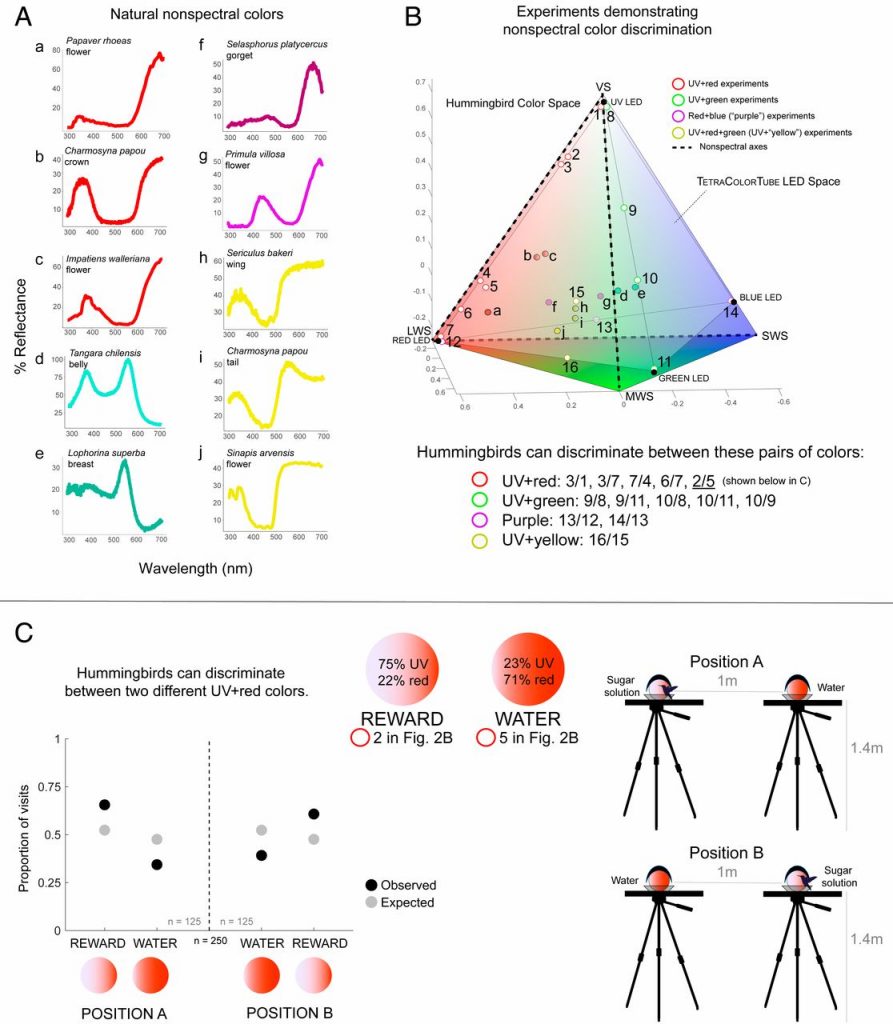“Humans are color-blind compared to birds and many other animals”, said Mary Caswell Stoddard, an assistant professor in the Princeton University, Department of Ecology and Evolutionary Biology. It is really astonishing to hear such and you might wonder then who are the masters of color vision.
Like most primates, humans are trichromatic. That means, our eyes have three types of color-sensitive receptors or cones: blue, green, and red. But birds are tetrachromats having four color cones, where the fourth cone is sensitive to ultraviolet light. They are able to discriminate a wide range of colors, including many non-spectral colors. This kind of color vision system likely evolved in early diurnal vertebrates, which possessed four types of visual pigments in their cone photoreceptors. This indeed serves in the evolution of colorful signals useful foraging, mate choice, social signaling, and predator-prey interactions across vertebrate animals.
This kind of color vision system likely evolved in early diurnal vertebrates, which possessed four types of visual pigments in their cone photoreceptors. This indeed serves in the evolution of colorful signals useful foraging, mate choice, social signaling, and predator-prey interactions across vertebrate animals.
Monochromatic colors in the rainbow are often called spectral colors. In terms of perception, spectral colors arise when light mainly stimulates a single color cone type or two spectrally adjacent cone types. Non-spectral colors are not part of the rainbow and hence are perceived when nonadjacent cone types are predominantly stimulated. For humans, purple; perceived by the simultaneous stimulation of SWS (blue) and LWS (red) cones, while the MWS (green) cone is not substantially stimulated., is a non-spectral color. But the amazing fact is that the fourth color cone of birds creates many more possibilities in the perception of colors such as UV+red and UV+green. It is more impressive as this broad range of hues has a biological and ecological relevance to them.
Theoretically, the increased dimensionality of color vision relative to humans contributes to an expansion of hues perceptible to birds and that serves as an advantage for flowers as they can advertise a nectar reward in a quite efficient manner. The avian tetrahedral color space is a type of chromaticity diagram, in which any bird-visible color can be mapped as a point defined by the relative stimulation of the four-color cone types. A basic assumption of tetrachromatic vision is that birds can distinguish colors throughout this entire space: colors resulting from interactions of all four color cone types, not only allowing perception of spectral colors but also non-spectral colors.
To investigate how birds witness their radiant world, Stoddard and her research team worked at the Rocky Mountain Biological Laboratory (RMBL) in Gothic, Colorado and the researchers trained wild broad-tailed hummingbirds (Selasphorus platycercus) to participate in color vision experiments. Hummingbirds are an excellent candidate group for studying color vision outside the laboratory. As they evolved to respond to colorful floral promotions of nectar, hummingbirds can be easily trained to associate different colors with a reward and have proven to be outstanding for examining cognition in the wild.
In this experimental study, they designed and deployed calibrated, field-portable light-emitting diode (LED) devices, the TETRACOLORTUBES, which can be programmed to display a broad range of bird-visible colors. In order to test the hypothesis that hummingbirds can discriminate a variety of non-spectral colors, they used an experimental paradigm in which birds were trained to associate a color with a rewarding sucrose solution.
It is found that non-spectral color perception is vital for hummingbirds in signaling and foraging. It is explained that broad-tailed hummingbirds consistently choose the feeder with the sweet taste, regardless of whether they had a non-spectral or spectral color. Though the colors looked the same to humans, they distinguish a difference and make the choice. They can discriminate non-spectral colors throughout the avian tetrahedral color space; either a non-spectral color and its “pure” components or two mixtures of non-spectral colors. Also, these marvelous creatures can discriminate against a ternary non-spectral color, UV+yellow, from at least one of its component colors (yellow). This shows the capacity for rich non-spectral color perception in these birds of paradise.
By analyzing the existing data of various bird plumage color and plant colors by the researchers, they found that hummingbirds would be able to see 30% of the birds’ plumage and 35% of the plant colors in non-spectral hues. Purple (SWS+LWS) and UV+purple (UVS+SWS+LWS) non-spectral colors are much more common in plants than in plumage, perhaps due to anthocyanin pigments, which plants produce but birds cannot synthesize in their feathers. The rarity of purple colors in plumage makes it a particularly salient color for flower pollination. This ability of discrimination between a broad range of hues likely helps the small birds locate a diverse variety of plants and their nectar. Hence, birds perceive non-spectral colors, because these colors are prevalent in their natural environments.
This finding would lead to providing a novel glimpse of visual ecology and ecological validity proving that every creation in mother nature is of vital importance in the existence and evolution of organisms on earth.
References:
- Mary Caswell Stoddard, Harold N. Eyster, Benedict G. Hogan, Dylan H. Morris, Edward R. Soucy and David W. Inouye. Wild hummingbirds discriminate nonspectral colors. PNAS, 2020 DOI: 10.1073/pnas.1919377117
- Princeton University. “Spectacular bird’s-eye view? Hummingbirds see diverse colors humans can only imagine: Team trains wild hummingbirds to discriminate UV color combinations.” ScienceDaily. ScienceDaily, 15 June 2020. <https://www.sciencedaily.com/releases/2020/06/200615155114.htm>.
Image Courtesy:
- Featured Image: https://bit.ly/2NeVU69
- Content Image 1: https://bit.ly/3hJkH0c
- Content image 2 & 3: https://bit.ly/2V3KDtE



